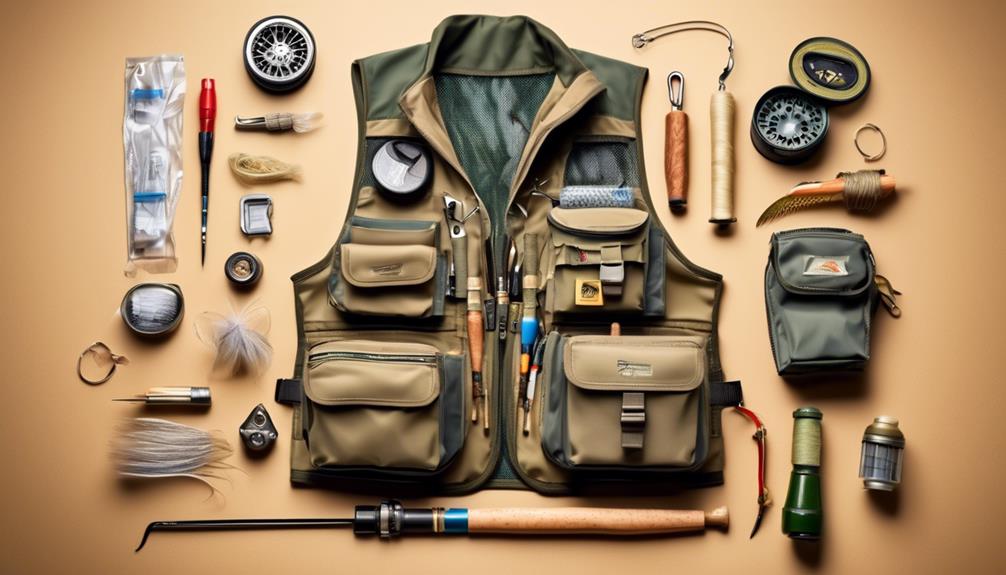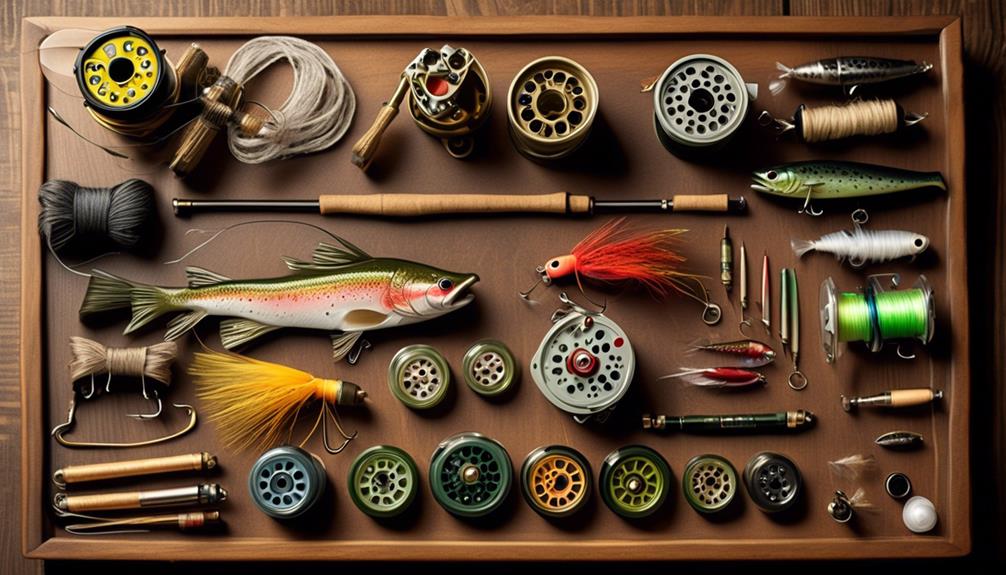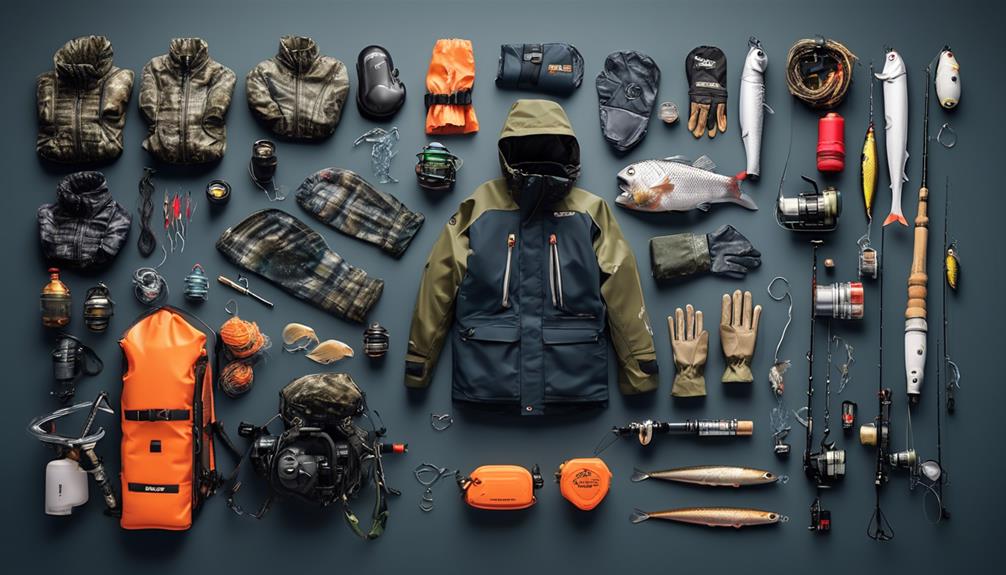Picture yourself standing in a serene river, the early morning mist rising off the water as the sun begins to peek over the horizon. You've got your fly rod in hand, and the anticipation of what the day's fishing holds is palpable.
But do you have the right tackle to make the most of this experience? In the world of fly fishing, having the right gear can make all the difference between a frustrating day and a truly memorable one.
Stay with me as we explore the top recommendations for fly rods, reels, lines, and more, so you can make the most of your time on the water.
Fly Rods
When choosing a fly rod, consider the weight and action that best suit your casting style and the type of fishing you plan to do. Rod selection plays a crucial role in your fly fishing experience.
The weight of the rod is determined by the size of the flies and the size of the fish you plan to catch. Lighter rods are suitable for smaller flies and fish, while heavier rods are better for larger flies and fish.
The action of the rod refers to its flexibility and how it bends when casting. Fast action rods bend mostly near the tip, allowing for longer casts and better accuracy, while slow action rods bend throughout the length of the rod, making them more forgiving and suitable for short-distance casting.
Understanding different casting techniques is essential when selecting a fly rod. If you prefer to use the overhead cast, a fast action rod might be more suitable for you as it generates higher line speeds, allowing for longer casts. On the other hand, if you're more inclined towards roll casting or other short-distance techniques, a slow action rod could be a better fit due to its flexibility and ease of control.
Fly Reels
To select a fly reel, consider the weight and capacity that best match your fishing needs and the type of fish you intend to pursue. Choosing the right size is crucial for a balanced setup. For smaller fish like trout, a lighter reel in the 3-5 weight range is suitable, while larger species like salmon or steelhead may require a heavier reel in the 7-9 weight range.
When it comes to maintenance, keeping your fly reel clean and well-maintained is essential for its longevity and optimal performance. After each use, gently rinse the reel with freshwater to remove any dirt or debris. Then, wipe it down with a soft cloth to prevent corrosion. Every few months, disassemble the reel and clean the internal components with a mild soap solution, ensuring all parts are thoroughly dried before reassembly. Additionally, applying a light coat of reel lubricant to the moving parts will help prevent rust and maintain smooth operation.
Choosing a reel with a sealed drag system can also minimize the need for frequent cleaning and maintenance, making it a practical option for anglers who fish in saltwater or dusty environments. Ultimately, investing time in proper cleaning and maintenance will prolong the life of your fly reel and ensure it performs flawlessly when you're out on the water.
Fly Lines
Proper selection of fly lines is crucial for achieving accurate casts and effectively presenting flies to the fish. When it comes to casting techniques, matching the fly line weight to the rod weight is essential. Different casting techniques, such as overhead casting, roll casting, and mending, require specific types of fly lines.
For instance, a weight-forward fly line is great for long casts and general fishing situations, while a double taper fly line provides more delicate presentations and better line control for mending. Understanding the different tapers and weights of fly lines will greatly enhance your casting abilities and overall fishing experience.
In addition to casting techniques, proper line maintenance is vital for ensuring the longevity and performance of your fly line. Regular cleaning and conditioning of the fly line is necessary to remove dirt, debris, and line dressing buildup, which can affect the line's buoyancy and casting ability. It's also important to inspect the line for any signs of wear and tear, such as cracks or nicks, as these can lead to decreased performance and even breakage during a crucial cast.
Leaders and Tippets
Selecting the right leaders and tippets is crucial for maintaining a good fly presentation and achieving successful fly fishing. When it comes to leaders and tippets, there are a few key factors to consider to ensure you're fully prepared for a successful day on the water.
- Strength and Diameter: The strength and diameter of your leaders and tippets can significantly impact your success on the water. Choosing the appropriate strength for the type of fish you're targeting and the diameter that matches the size of your flies are essential for effectively presenting your fly and landing fish successfully.
- Knot Tying: Proper knot tying is paramount when it comes to leaders and tippets. Knowing how to tie strong and reliable knots is crucial for securing your flies and ensuring a solid connection between your fly line and leader. Practice your knot tying skills regularly to ensure you can tie secure knots even in challenging conditions.
- Casting Techniques: Understanding how leaders and tippets affect your casting is essential for achieving accurate presentations. Different leader and tippet setups can impact the way your fly casts and lands on the water. Experiment with various leader and tippet combinations to find the setup that works best for your casting style and the conditions you're fishing in.
Flies and Lures
When choosing flies and lures for fly fishing, consider the specific characteristics of the water and the target fish to maximize your chances of a successful catch. Pay attention to casting techniques and fly selection to ensure an effective and enjoyable fishing experience.
Casting techniques play a crucial role in fly fishing success. Different flies and lures require specific casting methods to mimic natural movements and entice the fish. For example, when using streamer patterns, which imitate small baitfish, mastering the art of the strip retrieve can significantly increase your chances of attracting aggressive game fish. On the other hand, dry flies, designed to float on the water's surface, often require delicate and precise presentations to fool selective trout or other surface-feeding fish. Understanding these nuances and practicing different casting techniques will enhance your overall fly fishing proficiency.
Fly selection is equally important. Streamer patterns, such as Woolly Buggers and Clouser Minnows, are effective for targeting predatory species like bass and pike. These flies are typically cast across current or retrieved through still water to provoke aggressive strikes.
Conversely, dry flies, like Adams and Elk Hair Caddis, are designed to imitate insects that land on the water's surface, making them ideal for enticing fish during insect hatches or when fish are actively feeding near the water's surface. By carefully considering the water conditions and the behavior of the target fish, you can choose the most suitable flies and lures to maximize your fly fishing success.
Waders and Boots
Invest in high-quality waders and boots to ensure your comfort and safety while fly fishing in various water conditions. Proper sizing and material quality are crucial factors to consider when choosing the right gear for your fly fishing adventures.
When it comes to waders and boots, remember these important points:
- Proper Sizing: Ill-fitting waders can lead to discomfort and restricted movement, while boots that are too loose or too tight can cause blisters and sore feet. Ensure you carefully follow sizing guides and consider trying on different options to find the perfect fit.
- Material Quality: Opt for waders and boots made from durable, waterproof materials such as neoprene, Gore-Tex, or breathable fabrics. High-quality materials will keep you dry and comfortable, even during long hours spent in the water.
- Safety and Confidence: Investing in well-fitted, high-quality waders and boots not only ensures your comfort but also enhances your safety and confidence while navigating through different water terrains. With the right gear, you can focus on enjoying the fishing experience without worrying about discomfort or potential hazards.
Tools and Accessories

For optimal fly fishing success, ensure you have the essential tools and accessories readily available in your tackle box. When it comes to fly fishing, having the right tools and accessories can make all the difference.
One crucial tool to have is a fly tying kit. This kit typically includes a vise, scissors, bobbins, and a variety of threads and materials for fly tying. Being able to tie your own flies gives you the flexibility to match the hatch and adapt to changing conditions on the water. It's a skill that can greatly enhance your fishing experience.
In addition to fly tying, having the ability to tie strong and reliable knots is essential. A good pair of knot tying tools, such as a knot-tying tool and a nail knot tool, can make the process much easier, especially when dealing with small flies and tippet. Being proficient at tying knots like the improved clinch knot, the non-slip loop knot, and the blood knot can greatly improve your success on the water. Plus, having the right knot tying tools can save you from frustration when dealing with cold or wet hands.
Storage and Organization
To keep your fly fishing tools and accessories in top condition and readily accessible, efficient storage and organization methods are essential in ensuring a successful fishing trip. Proper gear storage is crucial for protecting your valuable equipment and ensuring that everything is easy to find when you need it most. When organizing your fly fishing gear, tackle boxes become invaluable for keeping everything neatly in place and preventing items from getting lost or damaged.
Additionally, having a designated space for each piece of equipment can help streamline your fishing experience, allowing you to focus on the thrill of the catch rather than searching for misplaced items.
When it comes to gear storage, fly fishing enthusiasts often find that investing in high-quality tackle boxes is well worth the expense. These sturdy containers provide individual compartments for flies, leaders, tippets, and other essential items, keeping everything organized and easily accessible. Moreover, tackle boxes come in various sizes and styles, allowing you to choose one that best suits your specific needs and preferences. A well-organized tackle box can bring a sense of calm and preparedness, enhancing your overall fishing experience and boosting your confidence on the water.
In addition to tackle boxes, implementing a strategic organization system for your gear can significantly improve your fly fishing outings. Utilizing gear bags, vests, or other storage solutions can help ensure that all your equipment is in its rightful place, allowing you to focus on what truly matters – enjoying the art of fly fishing.
Frequently Asked Questions
What Are the Best Techniques for Casting a Fly Rod in Different Weather Conditions?
In windy conditions, you'll want to adjust your casting technique for accuracy. Focus on a shorter, more controlled backcast, and use the wind to your advantage by casting with the wind at your back.
When it's rainy, be mindful of the weight of your fly and line, as water can make them heavier. Adjust your casting stroke to maintain accuracy and reduce water drag on your fly.
How Do I Properly Maintain and Clean My Fly Reel to Ensure Its Longevity?
To properly maintain and clean your fly reel for longevity, start by ensuring proper storage. Keep it in a dry, cool place to prevent corrosion.
When cleaning, disassemble the reel and use a mild soap and water solution. Gently scrub with a soft brush to remove dirt and debris.
Dry thoroughly and apply a light coat of reel oil to the moving parts.
Regular maintenance will keep your reel in top condition for many fishing trips.
What Are the Advantages of Using a Specific Type of Fly Line for Different Types of Fish Species?
When you're fly fishing, using a specific type of fly line for different fish species has several advantages. It can improve your casting techniques and help you adapt to different weather conditions.
For example, a heavier weight forward line is better for casting larger flies, while a lighter weight line is more suitable for delicate presentations to smaller fish.
Matching the right fly line to the fish species and conditions can make a big difference in your success.
How Do I Choose the Right Leader and Tippet Material for Different Fishing Environments?
When choosing leader and tippet material for different fishing environments, you should consider knot tying techniques and fly selection strategies. Different fish species and water conditions require specific materials and knots.
For example, in clear water, use a longer, thinner leader to avoid spooking fish.
For larger, aggressive fish, opt for a stronger, thicker tippet.
Match the tippet size to the fly size for a natural presentation.
What Are Some Lesser-Known Fly Patterns or Lures That Have Proven to Be Effective in Certain Fishing Situations?
When you're exploring unconventional fishing scenarios, it's worth trying unique fly patterns or specialized lures. These less-known options can lead to unexpected catches, bringing excitement to your fishing outings.
Some anglers have found success with patterns like the Chernobyl Ant or the Gurgler, while others swear by lures such as the Mouse or the Hopper.
Experimenting with these unconventional choices might just lead to some memorable fishing experiences.
Conclusion
Now you're ready to hit the water with the best fly fishing tackle.
With top-notch gear in hand, you can confidently cast your line and reel in the big ones.
From rods and reels to flies and waders, you've got everything you need for a successful fly fishing adventure.
So grab your gear, head to your favorite spot, and get ready for some unforgettable fishing experiences!



